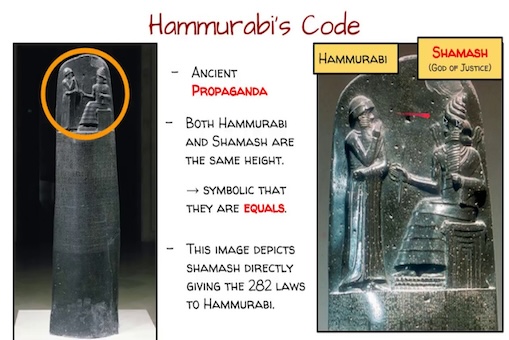Introduction
The Code of Hammurabi, a 4,000-year-old legal document from ancient Mesopotamia, stands as one of humanity's earliest examples of codified law. At the heart of this ancient legal code are principles of justice, property rights, and societal order that continue to influence legal systems and ethical discussions to this day. In this article, we will delve into the historical context, key provisions, and enduring legacy of the Code of Hammurabi.
Historical Context
- Ancient Mesopotamia: The story of the Code of Hammurabi unfolds in ancient Mesopotamia, a region located between the Tigris and Euphrates rivers in what is now modern-day Iraq. This fertile land witnessed the rise of numerous city-states, each with its own governing systems and laws.
- Reign of Hammurabi: Hammurabi, the sixth king of the First Dynasty of Babylon, reigned from approximately 1792 to 1750 BCE. His reign marked a period of significant political consolidation and cultural development in Mesopotamia.
Creation of the Code
Hammurabi's primary aim in creating the code was to establish a uniform set of laws that would apply to his subjects across the city-states under his control. The code was inscribed onto a massive stone stele, which was erected in a public place for all to see, emphasizing transparency and accessibility.
Key Provisions of the Code
The Code of Hammurabi comprises 282 laws or legal provisions that cover a wide range of subjects, reflecting the societal norms and values of ancient Mesopotamia. Some of the key provisions include:
- Criminal Law: The code addresses various criminal offenses, such as theft, assault, false accusations, and murder. Punishments for these crimes ranged from fines and restitution to physical punishments and death. Importantly, the code introduced the principle of "lex talionis," often summarized as "an eye for an eye," reflecting the concept of retributive justice.
- Civil Law: It regulates matters related to property rights, contracts, and family law. Provisions include rules on landownership, property disputes, marriage contracts, divorce, and inheritance.
- Commercial Law: The code establishes regulations for trade and commerce, including rules for contracts, warranties, and the responsibilities of merchants and traders. It also standardizes wages for laborers and skilled workers.
- Consumer Protection: The code contains measures to protect consumers by setting standards for goods and services. It includes penalties for fraud and misrepresentation, ensuring fair trade practices.
- Family and Marriage: Provisions within the code address matters of family law, including the rights and responsibilities of spouses, parents, and children. It outlines procedures for marriage contracts and divorce.
- Legal Procedures: The code outlines legal procedures, emphasizing the use of witnesses and evidence in court to ensure fair trials and just outcomes.
Principles and Significance
- Retributive Justice: The principle of "an eye for an eye" reflected in the code underscores the concept of retributive justice, where punishments are designed to correspond to the severity of the crime.
- Formalized Legal System: The Code of Hammurabi is a testament to the formalization of legal systems in the ancient world. It introduced a structured framework with specific rules and procedures for legal matters, marking a significant advancement for its time.
- Preservation of History: Beyond its legal content, the code provides valuable historical insights into the social, economic, and legal conditions of ancient Mesopotamia. It allows scholars to reconstruct aspects of daily life and governance in this distant era.
Legacy and Influence
The Code of Hammurabi has left an indelible mark on the fields of law, ethics, and historical understanding:
- Legal Precedent: It established a precedent for codifying laws, setting the stage for subsequent legal systems in various cultures and civilizations.
- Historical Perspective: The code offers a unique window into the social, economic, and legal conditions of ancient Mesopotamia. Researchers use it to gain insights into the evolution of societal norms and governance.
- Comparative Legal Studies: The code enables scholars to engage in comparative legal studies, analyzing the similarities and differences between ancient legal systems and modern ones.
- Ethical Discussions: The principles of justice and legal order embodied in the Code of Hammurabi continue to inspire discussions on ethics, justice, and the role of law in society. It prompts reflection on the enduring values of fairness, accountability, and the rule of law.
Conclusion
The Code of Hammurabi stands as an enduring testament to the human quest for justice and order in society. It represents a pivotal moment in legal history when laws were formalized, providing clarity and structure for the governance of ancient Mesopotamian city-states. Beyond its historical significance, this ancient legal code continues to influence contemporary discussions on law, ethics, and the role of the legal system in maintaining order and justice. The principles and values embedded in the Code of Hammurabi resonate across millennia, reminding us of the enduring importance of fairness, accountability, and the rule of law in human civilization.


